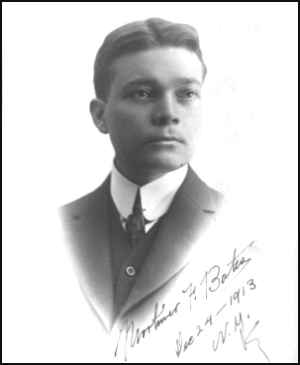
1883-1961 |
 |
|
Photo Courtesy of Ted Bates |
|
Via Email from Ted Bates, 11-28-02 grandnephew of Mortimer Mortimer Fleming Bates was born in Minneapolis, Minnesota on November 24, 1883. In 1924 he married a Mae Douglas, a descendant of the Douglas Aircraft founder, although I am not certain of her relationship. May died in 1929 of diphtheria. He married Evelyn Wille in 1930. In 1931 they had a son named Thomas W. Bates, who is still living. Mortimer Bates died in February 1961, in Burbank California. He was a civilian observer with the Sperry Corp. in Italy during WW1 and He worked for Hughes Aircraft in California. He was a member of the Early Birds and held AOPA license 68 to the best of my knowledge. |
|
Courtesy of Ted Bates "Mortimer F. Bates, now a mechanical engineering designer in Dept. 04, was one of the pioneer pilots. Holder of Pilot's license number 66. Mort is a member of the Early Birds Club, pilots of the baling wire days. Back in the days when anyone who wanted to fly was either a dern fool or a hero, Mortimer F. Bates, Mechanical Engineering designer in the R and D labs, earned pilots licnese number 66 from the Federal Aeronautical Internationale. It was 1911 and flight training consisted of a few hours taxiing up and down a vacant field in a grounded craft, a few hours making grasshopper jumps a few feet off the ground, and the final advanced phase of being airborne. All training was strictly solo as the wire and canvas contraptions passing at the time for airplanes accommodated only one person. Mort became interested in flying when the Wright Brothers made their Kitty Hawk flight in 1903. He joined Orville and Wilbur Wright in their Dayton, O. bicycle shop late in 1909. He stayed a year, assembling and testing the Wright's four cylinder engine, the only engine used by the Wright's. The V-8 engine used later consisted of two 4-cylinder engines placed together. Only three other persons besides the Wrights and Mort were employed in the shop at that time. While he was working there, Mort saw the formation of the Wright Exhibition Team, a barnstorming unit composed of young men who were trained to fly by Orville Wright. He also watched the organization of the Belmont Park Air Meet. The plane that was entered in this first contest by the Wright Brothers was called a "Baby Wright" and was put together in a few days for the meet. Mort worked on the engines for the plane during a midwest humid hot spell. The hours everyone in the bicycle shop had spent on the plane seemed worthless when the craft crashed during the meet. The First U. S. Army plane contract was awarded to the Wright Brothers in 1908. The cost was to be $25,000 and specifications ran for a speed requirement of 40 m.p.h. with a 30 h.p. engine to fuel for a 25 mile flight with a load of 350 pounds. Mort started working for the Sperry Gyroscope Co. in 1914 and went overseas during WW1 as an observer for Sperry. Mort also worked for Servomechanisms, Inc. and Kollmorgen Optical Corp. He joined Hughes Aircraft Company in September 1950 as an engineering designer." |
|
Early in 1911, Alfred Moisant opened an aviation school at Hempstead Plains, near Garden City, Long Island, where a vast acreage was admirably adaptable to practice flying. Alfred had the assistance of Harold Kantner, an early exhibition flyer, as well as of George H. Arnold, Mortimer F. Bates, J. Hector Worden, and Chief Pilot Shakir S. Jerwan---"all licensed aviators," as the prospectus put it The Story of the Early Birds Thomas Y. Crowell Co. |
|
Via email from Ted Bates (11-28-02) Roster, 1996 |


|